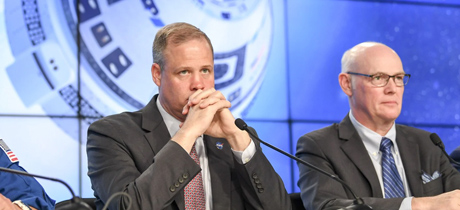In Today’s Deep Space Extra… The U.S. House Space Subcommittee’s proposed 2020 NASA authorization measure, HR 5666, continues to spur discussion as it nears a Wednesday markup. Government auditors cautioned Tuesday that the launch of the James Webb Space Telescope (JWST) could be delayed beyond March 2021. All eyes on the skies over Pittsburgh Wednesday night as two satellites pass close to one another.
Human Space Exploration
NASA has been touting Trump’s Moon plan for nearly a year. Now it faces its first real test in Congress
Coalition Member in the News – Boeing
Washington Post (1/28): After nearly a year of courting lawmakers and policy makers to support an accelerated return to the surface of the Moon with NASA astronauts in 2024, as directed by Vice President Mike Pence, NASA Administrator Jim Bridenstine faces a new challenge. Late last Friday, the U.S. House Science, Space and Technology Committee’s Space Subcommittee offered a bipartisan 2020 NASA authorization measure, HR 5666, that would move the lunar return goal to its previous 2028 and direct NASA to press toward a human expedition to Mars orbit in 2033. The measure would also ease commercial participation in the development of human lunar landers in favor of an upgrade to the Space Launch System’s (SLS) upper stage. The subcommittee has scheduled a markup session on the measure Wednesday at 2 p.m., EST.
Astronaut craves salsa and surf after record 11 months aloft
Associated Press via New York Times (1/28): February 6 is to mark the return to Earth of NASA astronaut Christina Koch, who launched to the International Space Station (ISS) last March and soon agreed to extend her stay to a record 328 days for a woman. A Russian Soyuz capsule carrying Koch, European Space Agency (ESA) astronaut Luca Parmitano and cosmonaut Alexander Skvortsov is to descend into remove Kazakhstan for a landing. Koch, an electrical engineer, stressed the value of diversity among members of the astronaut corps. As she prepares to return to Earth, Koch is savoring the taste of salsa and a swim in Galveston Bay, she told the news service in an interview Tuesday.
The ISS is to get a new commercial habitable module (and it might be pretty cozy)
Coalition Member in the News – Axiom Space
Technology Review (1/27): NASA has selected Houston-based Axiom Space to build and deploy a habitable module that will be attached to the International Space Station (ISS) in the second half of 2024, it announced this week. Why? NASA wants to open the ISS up to commercial opportunities. Last year, it finally started accepting bids from private companies that want to use the Station’s resources and microgravity environment to test out new technologies, run different experiments, and even provide a potential destination for tourists looking for a short space getaway. As part of the new agreement, Axiom will attach a new kind of habitat module to the Station’s Node 2 docking port, for at least five years (with a two-year option to follow).
Space Science
GAO warns of more JWST delays
Coalition Member in the News – Northrop Grumman
SpaceNews.com (1/28): An audit of the NASA-led James Webb Space Telescope (JWST) issued Tuesday casts doubt on the readiness of the designated successor to the Hubble Space Telescope for launch as planned in March 2021. The JWST has a history of technical and cost issues, and its launch has experienced a number of setbacks. The audit from the U.S. General Accountability Office (GAO) refers to a joint confidence level assessment of cost and schedule from October. The outcome was a 12 percent confidence level that remaining pre-launch activities would lead a March 2021 liftoff. July 2021 may be more realistic, according to the report.
NASA, partners name ocean studying satellite for noted Earth scientist
NASA/Jet Propulsion Laboratory (1/28): Michael Freilich, NASA’s now retired long time director of the Earth Science Division, was announced Tuesday as the namesake of the Sentinel 6A ocean surveillance satellite scheduled for launch from Vandenberg Air Force Base, California, this fall. Sentinel-6B is to launch five years later. The mission is a NASA/European Space Agency (ESA) undertaking with participation from other international partners.
Hottest known exoplanet is so hot, it’s tearing its molecules apart
Space.com (1/28): KELT-9B is the hottest extra solar planet found so far. Three times larger than Jupiter, it closely orbits a star 670 light years from Earth. The star and planet are so close that internal temperatures on KELT-9B are 7,800 degrees F, so hot that hydrogen molecules in its atmosphere are shredded. The large planet may not be alone in its extremes. The study, which was conducted with space and ground-based telescopes, was published in the Astrophysical Journal Letters.
Other News
Two satellites will narrowly avoid colliding at 32,800 mph over Pittsburgh on Wednesday
Space.com (1/28): Two defunct satellites, NASA’s Infrared Astronomical Satellite launched in 1983 and the Gravity Gradient Stabilization Experiment launched in 1967 by the U.S. Air Force, are to pass close to one another over Pittsburgh on Wednesday just after 6:39 p.m., EST. LeoLabs, the satellite tracking company, predicts a miss distance of between 50 and 100 feet. However, should they impact the debris field could remain in Earth orbit for decades, according to the forecast.

